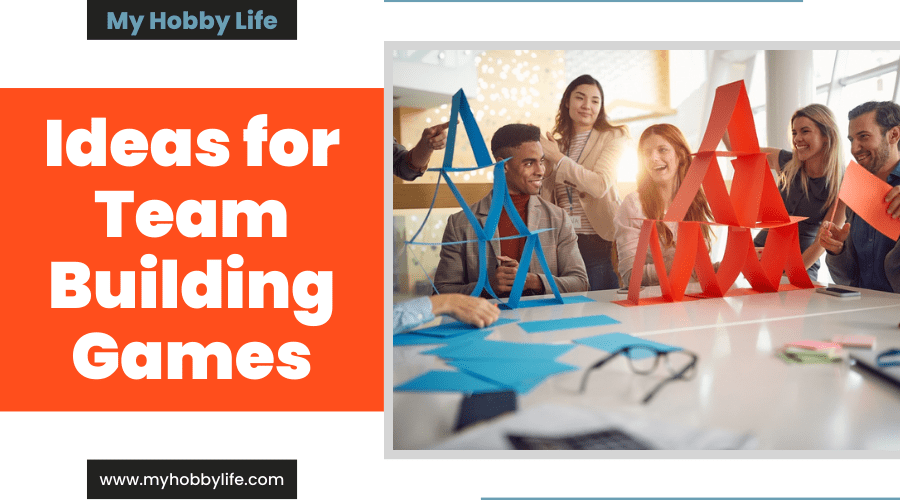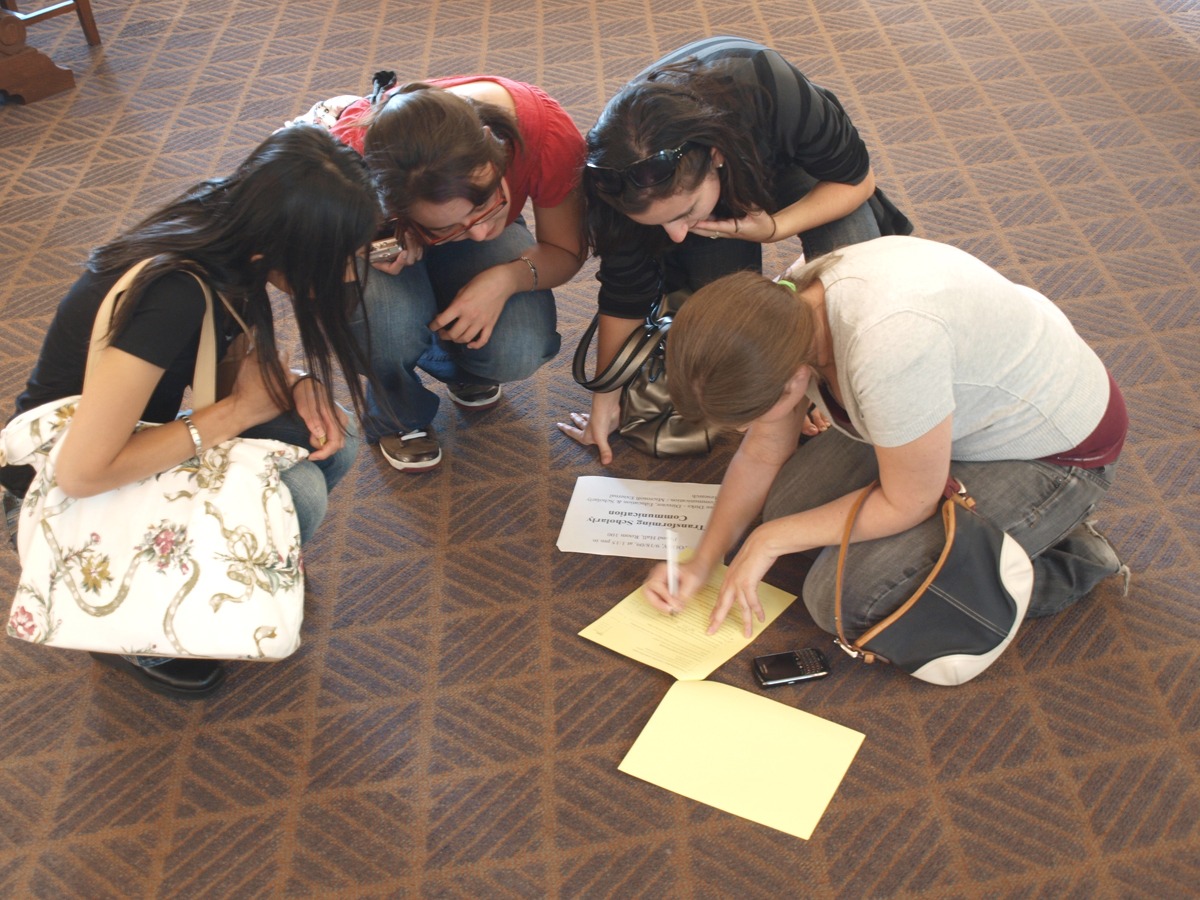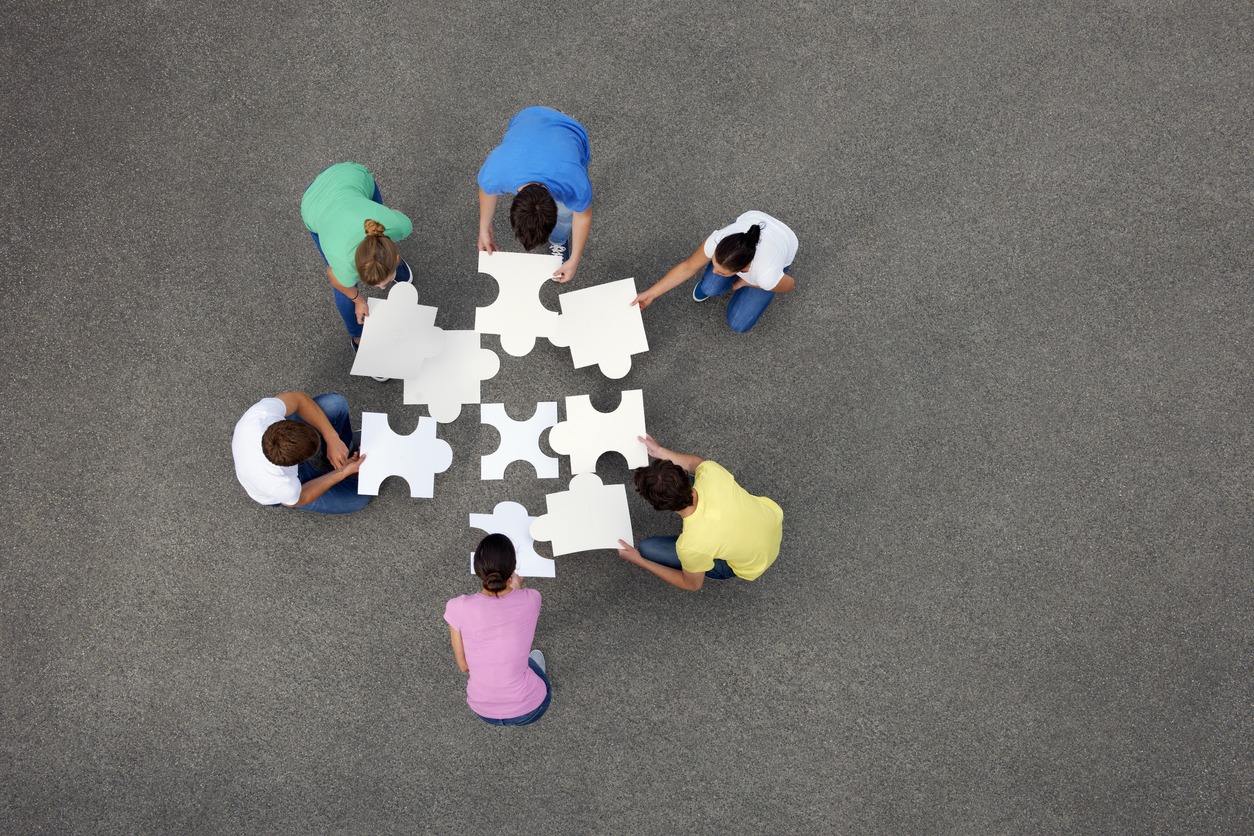Teams can work together from anywhere in the world because of technology, but that doesn’t mean they will work well together. It’s important that people on a team feel connected to each other in ways other than Wi-Fi. With the ease of digital communication (chatbots, AI assistants, WhatsApp, Slack, social media apps, etc.), it can be all too easy to let real-life connections fall through the cracks.
What are team building games?
Team building games are competitions that are meant to help people work together better and make friends with each other. Most of the time, these games don’t have high stakes and are more about having fun than winning. These activities are also called “team building activities,” “team bonding games,” and “team games for work.”
20 Best Team Building Games
These unexpectedly engaging team building games are likely to be a success at your company, including activities that keep you on your feet and others that challenge your knowledge.
1. Team Building Bingo
Putting together a team Bingo is a fun, simple game that may help you discover more about the individuals with whom you work. Make a list of unusual things you’ve done before playing, put them on individual “bingo boards,” and distribute the boards to everyone on your team. Throughout the game, players question each other whether they have completed the tasks listed in the gaps. If a player has experienced the experience, that player signs the bingo card area of the person who posed the question. The round is won by the first player who gathers enough autographs to form a line across the board, much as in regular bingo. This line might be horizontal, vertical, or angled.
2. Pub-like Trivia
Pub-like Trivia is a great way to test the knowledge of your team at work, even if your workplace doesn’t allow alcohol. First, prepare a list of trivia questions. The best trivia questions are about things that most people don’t know. After you’ve thought of your questions, put the players into groups. Before answering, teams can talk about the answers in private. The winning team is the one that gets the most questions right. This is a great team-building game because teams have to work together and share their knowledge to win.
3. Guess the Baby
Guess the Baby is a fun game in which players try to figure out whose baby picture is whose. Before the game starts, ask each team member to send in a picture of their baby or toddler. Then, put the pictures of the babies up where everyone can see them, and have team members fill out a form or write their guesses on post-it notes. The person on the team who names the most babies correctly wins. Guess the Baby brings the team closer together by giving them a chance to talk about their childhoods with each other.
4. Secret Gifter
Secret Gifter is a gift exchange game that is similar to Secret Santa. You can play it any time of the year. When a player sends in a name, they get a subject to buy gifts for. Set a price limit and buy the gifts as a company to make sure they are all the same quality and cost the same. Then, on the set day, exchange gifts in public. Team members try to figure out who their Secret Gifter is during the gift exchange. If a member of a team guesses right, that team wins! Secret Gifter is a fun game because it makes people on a team learn more about each other so they can buy the right gift for each other.
5. Murder Mystery Party
A murder mystery party is a role-playing game for people who like murder mysteries like Knives Out. Each person on the team gets a role to play, and the goal is to figure out who did it. Some murder mystery hosts make up their own stories. If you’ve never been to a murder mystery party before, choose a free one that’s already made. To give your team even more of a reason to work together, you can also give prizes to members who correctly guess who the murderer is.
6. Codenames
Codenames is usually played with a board and a group of people. But you can also play Codenames online, which is a great way to build teamwork on remote teams. At the beginning of the game, everyone can look at a set of word cards. The players are then split into two groups, and each group chooses a spymaster. The spymaster’s job is to get their teammates to guess the words marked with their team’s color. The game is won by the first team to guess all of their cards. Codenames is a fun game to play with a group because everyone has to work together to win.
7. Scavenger Hunt
Distribute your team into equal-sized groups and send them out with a list of objects to find and return. It is entirely up to you whether they stay in the workplace or depart. The final aim is to be the first to return with the most stuff. You may wish to establish a time restriction so that all groups return in a fair amount of time, whether or not they found all of the things. A themed scavenger hunt may include a variety of clues or other twists that encourage a team to be creative and work together.
Make it a digital scavenger hunt in which students must identify particular examples and information or web sites online. You may want to limit the search engines or strategies they utilize to fulfill the task.
A scavenger hunt is a fun game that requires participants to collaborate as a group. It stimulates creativity, especially when hints or riddles are incorporated.
8. ABC Hunt
ABC Hunt is a fun indoor team-building game that gets everyone up and moving. In this game, the host chooses three letters of the alphabet at random, and the rest of the team tries to find things that start with each letter. The winner is the person who finds three things the fastest. ABC Hunt is also a versatile DIY team building game because teams can play it both at home and at the office.
9. Ambassadors
Ambassadors is a fun, no-materials-needed game where people on a team act as ambassadors for other countries. After giving each player a country using a random country generator, each ambassador has to talk about the country they were given without saying the name of the country. The player who gets the most countries right is the winner. Ambassadors is a great game for building teams because it is educational and requires your team to use their creativity and communication skills.
10. Hangman
Hangman, a game you’ve certainly played as a youngster, may also be useful for team building. Hangman not only familiarizes your team with the rules, but it also improves your team’s vocabulary and develops common references that might be wonderful future discussion starters. Hangman is also great for team development since it forces your colleagues to collaborate in order to correctly guess the word.
11. Alphabet Chain
Alphabet Chain is an excellent game for teams looking to expand their vocabulary. In this game, your team must first agree on a subject. The team members must then identify terms that pertain to that issue. Every suggested word, however, must begin with the final letter of the preceding one. If a team member cannot come up with a proper term and thereby breaks the chain, that person must withdraw. The game is won by the individual who is the last one standing. Because Alphabet Chain simply needs a large vocabulary to play, no resources are required, making it a simple game to learn.
12. Dance Off
Dance Off is a fun game in which your team expresses themselves via dance. The goal of Dance Off, as the name indicates, is for your team to compete to find who the finest dancer is. Provide a playlist of danceable songs and make room for your squad to move freely. Then, have your group form a circle and start performing music. Each team member is given a few minutes in the middle of the circle to demonstrate their techniques. Everyone votes for the best dancer, and the one with the most votes win. Dance Off allows your team to have fun while staying active, which is fantastic for stress alleviation.
13. Heads Up!
Heads Up! is an app-based party game that may also be played at work. Ellen DeGeneres created Heads Up! which can be played with any number of players, making it suited for both big and small groups. After selecting a deck, a team member places a phone on their forehead with the screen facing outward. A word will display on the screen, and the other players will provide tips to assist the team member with the phone in determining what the word is. Heads Up! is an exciting cooperation game because it offers a fascinating circumstance in which your team must collaborate to win.
14. No Context Pictures
No Context Pictures is an entertaining indoor team building game that allows you to learn more about your teammates’ personal life. Request that your team submit an unusual picture with no context prior to the game. The images should then be posted somewhere where everyone in the team can view them. Request that team members offer brief descriptions of what is occurring in the photographs. The individual who first submitted the picture votes on which tale they prefer. No Context Pictures is an excellent team building game because it allows you to get a more comprehensive view of your colleagues by displaying an aspect of their life that you may not see at work.
15. Plant Babies
Plant Babies is a workplace game that encourages your staff to grow plants at their workstations as the mental health benefits of plants become increasingly well-known. For this game, each team member needs adopt a plant to care for. Then, when the Plant Babies reach particular milestones, such as reaching a certain height or producing flowers, team members get points. The team member with the most points at the conclusion of each three-month term wins. Plant Babies encourages your team to nurture caring spirits and allows your employees to collaborate to create a more delightful working atmosphere.
16. What’s On My Desk?
What’s On My Desk? is an office game in which team members put their knowledge of one another to the test. Request that team members share images of their workstation setting for this game. Once the images are in, upload them in a public area where everyone may view them. Then, ask your team to guess which desk belongs to whom. The player who correctly predicts the most number of workstations wins. What’s On My Desk? is a fun game since it allows your team to get to know one another via desk artifacts.
17. My Next Meal
My Next Meal is the activity to attempt if your team is looking for new dishes to test. Each week, a different member of the team sends a snapshot of what’s inside their refrigerator. Then, other team members offer inventive dishes based on the photo’s elements. Everyone votes for the best recipe, and the recipe with the most votes is declared the winner. My Next Meal relieves the stress of meal preparation while simultaneously bringing team members together via a shared love of food.
18. Two Truths and One Lie
Another enjoyable technique to discover more about your coworkers is to play Two Truths and One Lie. Best of all, there are no ingredients required for this game! A team member in this game makes two accurate statements and one untruth. The other members must determine which assertion is false. If any of the team members correctly guesses, they get a point. If no one properly guesses, the individual who presented the assertions earns a point. The individual with the most points at the conclusion of the game is the winner.
19. Never Have I Ever
Never Have I Ever is a popular game that may be played in the workplace as well as at camp. Players begin by holding up five fingers. The participants then form a circle and mention something they have never done before. “I’ve never cooked banana bread,” for example. Any team member who has experienced the aforementioned experience raises a finger. The winner is the individual who is still holding up their fingers at the conclusion of the game. Never I Have Ever teaches participants several intriguing and unexpected facts about their workplace.
20. My Superhero Backstory
My Superhero Backstory puts your team’s imagination to the test by having employees create interesting superhero-like origin tales for colleagues. These anecdotes, which should be based on actual events, should explain how the team member came to work for your firm. The greatest tale is then voted on by team members. My Superhero Backstory is a great team building game because it produces inside jokes that help team members connect.
How to Plan the Perfect Team Building Exercise
The exercise must be appropriately planned in order for participants to get the advantages of team building. The finest team development activities have the following features:
1. Focus on inclusivity
Everyone should be able to engage in the activity without feeling excluded or stigmatized. This may imply that you must limit your attendance to remote events, activities that do not involve much physical exertion, or events that are within walking distance of your workplace (or in-office). Furthermore, your team-building activities should encourage everyone to engage, including those who are timid or soft-spoken.
2. Set clear expectations
Before the event, everyone should understand why you’re hosting it and how it will unfold. This will end the “why are we doing this?” and “I’m not sure what this is all about” debate. Instead, everyone can become enthusiastic about the event and go in knowing exactly what they’re going to do.
3. Focus on team issues
You don’t have to make things awkward by sending an email stating, “We’re throwing a trust-building event due to X recent incident!” However, the team building activity you choose should be relevant to your team’s objectives and have an emphasis on success in certain areas.
4. Have a singular goal
Even if divided into teams, it is critical that everyone be working toward the same goal. A single aim promotes group cohesiveness and allows you to compare and contrast performance in the end.
5. Encourage openness and vulnerability
Encouraging openness and vulnerability among colleagues usually results in improved understanding, stronger relationships, and enhanced trust – three qualities of a successful team.
6. Establish ground rules
How will teams resolve conflicts? What is the duration of the event? Is there a dress code in place? Can family members participate? Setting ground rules ahead of time will ensure that the event runs as smoothly as possible.
7. Foster trust
It is not difficult to include trust-building into a team-building exercise, but it is extremely vital. When team members trust one another to perform effectively during low-stakes team building activities, that trust will transfer to high-stakes job assignments.
8. Vulnerable leaders
If the leaders aren’t willing to have fun, be foolish, and be vulnerable, why should any other employee? Leaders must set an example that everyone wants to emulate!
9. Facilitate activities that play to team members’ strengths
There are several team building exercises available, but not all of them are made equal. Finding the right team building exercise for your group will allow each member to shine! Consider who you’re arranging the event for, what they’re excellent (and awful) at, and how the activity will work for them when selecting an activity.
10. Create structure
Without structure, you won’t be able to reap the advantages of team building at work. A team building event without structure is just a work party! Your chosen activity should have clear goals, defined responsibilities, and a single purpose.
11. Participate as leaders
Leaders should be vulnerable, but in order to be vulnerable, they must participate! A strong leader is never “too busy” or “unavailable” to ensure the success of their team. If a team believes that their leader is not involved in their growth, they may believe that their efforts are futile.
12. Have no personal agenda
Team building exercises are not intended to pit workers against one another or to provide a chance for “payback.” They’re also not a chance for anybody to brag! Team building activities are designed to bring a group together and strengthen it.
13. Host a meaningful post-activity meeting
The finest team building exercises conclude with an intentional discourse that enables participants to reach their own judgments about their performance – what they did well and what may be improved next time. These discussions will aid in the application of the activity’s teachings to day-to-day job duties.
Benefits of Team Building
Businesses that invest in adequate staff development get long-term advantages. One aspect of growth that is sometimes ignored is team building. As a business leader, there are several advantages to adding team-building exercises and events into your corporate culture. Team building is time and effort well spent.
1. Building Trust Among Co-Workers
When coworkers are compelled to work on a project that is outside of their typical job responsibilities, they relax and let their guard down. After all, no one will be fired for failing to complete the scavenger hunt as quickly as possible. When barriers are removed, individuals participate in creative discussion to find answers to the problem at hand. Coworkers recognize that they are part of a team with a diversity of thoughts that may assist in issue solving. When coworkers return to their regular workplace activities, they have more confidence in one another.
2. Improving Company Morale
Team-building activities should be enjoyable and interesting for everyone. On the surface, strange team-building activities like inventing a device to catch an egg from a 2-foot drop without it shattering seem amusing. However, the inventive solutions are characterized by outlandish ideas, frequent laughing, and a united competitive spirit. These moments spill over into the workplace, connecting workers and enhancing overall corporate morale. High morale leads to increased production.
3. Better Communication
Team-building activities are intended to drive employees to think creatively about unusual challenges or to communicate about themselves in non-work contexts. The practice challenges participants to follow the script and communicate with one another. This has far-reaching implications. Coworkers not only learn about one other’s abilities and skills, but they may also learn about their cultural background. This explains why individuals may behave or talk differently from one another.
Business executives realize that a diverse workplace in which individuals respect each other’s backgrounds and ideas results in better communication and fewer misunderstandings or conflicts.
4. Uncover Leadership Qualities
When you throw a bunch of individuals together who don’t ordinarily have motivation to work together, natural personalities emerge. As a consequence, the wallflower may need to be persuaded to participate in the activity. It also gives individuals with natural leadership talents the opportunity to stand up and take command of the activity. Business owners might notice if someone has an authoritarian, coaching, or pacesetter leadership style. This enables corporate executives to better nurture current leaders and mentor emerging leaders inside the organization.
5. Identify Strengths and Weaknesses
People focus on their duties while going about their regular routines. This isn’t necessarily a complete picture of a person’s strengths and flaws. Team-building activities aid in the identification of fundamental qualities that businesses desire in their staff. Competitiveness, honesty, influencing, problem-solving, and goal setting are examples of competencies. Business leaders may recognize these characteristics and utilize this knowledge to establish a great team by investing in its personnel.
Conclusion
Team building exercises ensure that workers get to know one other well, learn to trust and rely on one another, and are driven to work together to complete tasks.
When you create a good work atmosphere in which everyone respects and understands one another, your company becomes unstoppable. Make these activities a regular occurrence rather than a one-time event.




